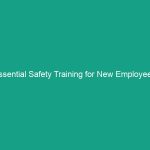Introduction
Good morning team! Today, we’re diving into a crucial topic that affects each of us in our work Environment: Master Confined Space Rescue Procedures. Understanding these procedures is not just a regulatory requirement; it’s a matter of life and death. Confined spaces present unique challenges and Hazards, and knowing how to effectively plan for and execute rescue operations can save lives. Let’s explore why mastering these procedures is essential for our Safety and how we can implement effective practices in our daily operations.
Understanding Master Confined Space Rescue Procedures
Confined space rescue procedures refer to the specific actions and strategies employed to rescue individuals who become trapped or incapacitated in confined spaces. These spaces are typically not designed for continuous occupancy and can include tanks, silos, sewers, and manholes, among others. The importance of these procedures cannot be overstated; they are essential for protecting our workforce and ensuring that everyone returns home safely at the end of the day.
Many employees may think that confined space work is infrequent or that it won’t happen to them. This misconception can lead to complacency and inadequate preparation. In reality, confined spaces can be found in many industries, and the risks associated with them are significant. Understanding these procedures is vital, as they directly impact our daily operations and overall Safety culture.
Key Hazards, Risks, and Safety Considerations
When it comes to confined spaces, several hazards can pose serious risks to employees:
- Oxygen Deficiency: Many confined spaces can have inadequate levels of oxygen, which can lead to unconsciousness or death.
- Toxic Gases: Confined spaces may contain harmful gases that can be lethal, such as carbon monoxide, hydrogen sulfide, or methane.
- Physical Hazards: These can include machinery, moving parts, or sharp objects that increase the risk of injury.
- Engulfment: Loose materials or liquids can pose a risk of engulfment, trapping workers beneath them.
Ignoring safety protocols in confined spaces can lead to devastating consequences, including severe injuries or fatalities. It’s crucial to recognize these risks and take them seriously to ensure a safe working environment.
Best Practices, Procedures, & Actionable Advice
Now that we understand the hazards, let’s discuss the Best Practices for confined space rescue procedures:
1. Pre-Planning and Risk Assessment
Before any work begins, a thorough risk assessment should be conducted. This includes identifying potential hazards, assessing the environment, and planning for emergencies. Document all findings and ensure that all team members are aware of the risks involved.
2. Training and Drills
Regular Training and practice drills are crucial for ensuring that all employees are familiar with rescue procedures. This includes:
- Understanding the specific hazards associated with the confined space.
- Practicing the use of rescue equipment.
- Conducting mock rescue operations to familiarize the team with emergency procedures.
3. Use of Personal Protective Equipment (PPE)
Ensure that all personnel entering confined spaces are equipped with appropriate PPE. This may include respiratory protection, helmets, gloves, and harnesses. Always check that the equipment is in good working order and suitable for the specific hazards present.
4. Emergency Response Plan
An effective emergency response plan is vital. This plan should include:
- Clear communication protocols.
- Designated roles for team members during a rescue.
- Access to emergency medical services.
5. Continuous Monitoring
During any confined space Operation, continuous monitoring of air quality and conditions is essential. Use gas detectors to monitor for hazardous gases and ensure oxygen levels are safe. Always have a standby rescuer ready to respond in case of an emergency.
Regulations, Standards, and Compliance
Compliance with safety Regulations is critical in confined spaces. Familiarize yourself with relevant Standards such as OSHA‘s Permit-Required Confined Spaces Standard (29 CFR 1910.146). Adhering to these regulations not only protects employees but also helps avoid legal repercussions and penalties for non-compliance. Ensure that your workplace has the necessary permits and that all procedures are documented and followed meticulously.
Employee Engagement & Discussion
Now that we’ve covered the essentials of confined space rescue procedures, let’s open the floor for discussion. What safety challenges have you encountered related to confined spaces? How can we improve our practices to ensure everyone’s safety? Your insights are invaluable in creating a safer workplace.
Conclusion & Key Takeaways
In conclusion, mastering confined space rescue procedures is not just a guideline; it’s an essential practice that ensures our safety. Remember these key points:
- Conduct thorough risk assessments before entering confined spaces.
- Participate in regular training and drills.
- Always use appropriate PPE.
- Have a robust emergency response plan in place.
- Stay compliant with safety regulations.
Let’s prioritize safety in our work and commit to applying these practices every day. Thank you for your attention and for your continued commitment to making our workplace a safe environment for everyone!


